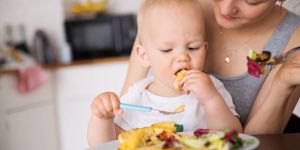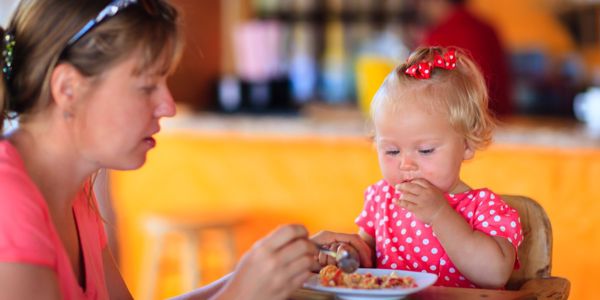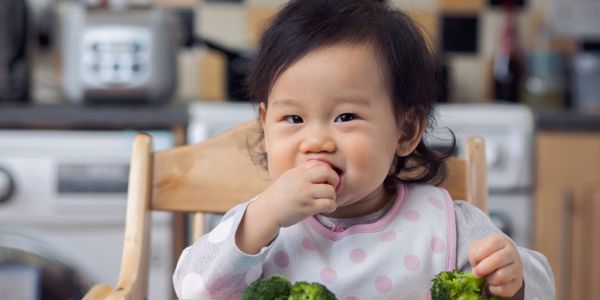In this article, I will be discussing how easy it is to have a healthy weaning diet at home. No need for fancy baby food in jars, just by starting off with simple and humble vegetables and fruits, moving on to combinations of those and finally main meals. I will also be sharing our weaning story, information about food allergies and finally useful facts for parents about to hit this milestone with their little ones. I go by my motto of Weaning is about Patience and Perseverance and it will keep you in good stead to remember that, even when you’re frustrated that your little one is turning their noses up at certain foods. It’s all about learning for them and for you. Food should be a positive experience and people should recognise that your child learns from your example, so take a positive and relaxed approach to food and hopefully, your little one will follow suit.
To begin I’m going to talk about weaning age, this is usually decided by a mixture of the child’s parents, a doctor or a health visitor depending upon if you need their advice. Most parents decide to wean their children around the age of six months. Due to my son being born just over what would have been considered as premature, we felt like he had constantly been playing catch up for his first few months, so I made the decision to start weaning him from six and a half months of age. He was also under a paediatric consultant at this time due to suspected food allergies that they couldn’t test for until he reached twelve months of age, so I had to monitor his weaning diet very closely.
Most parents begin weaning at six months and start with vegetables, only small spoonful’s to start with and slowly increase the amount day by day. After so many weeks of vegetables you can then move on to fruits, then a combination of the two, and then move on to other things such as carbohydrates and proteins at a later stage.
Our weaning story is a little different due to my son being born with food allergies. I was adamant that I wanted to cook foods at home for him to become weaned upon. Like most parents at this stage, I began with vegetables and fruits. Fact: The reason you should begin with vegetables is that otherwise a baby gets too used to sweet tastes like those in fruit and they are less likely to try and like a variety of vegetables after getting used to naturally occurring sugars at a young age.
I decided I would keep a food diary for two reasons; the first reason was to note down any potential reactions my baby A was having after consuming the foods. The second was to score how he took the food. Fact: Did you know that sometimes it can take up to three attempts for a baby to decide if they like something or not? So don’t give up! I have always said that Weaning is about the two P’s, Patience and Perseverance! Fact: You should always leave a disliked food for a couple of weeks before trying it again; never force-feed your child.
You can sign up to things like Ella’s Kitchen who generously send you a pack with stickers and a food and fruit chart, all of which can help you to keep track of what your little one may or may not like. Fact: When a baby decides they don’t like something it isn’t the end of that ingredient, leave them for several weeks or even months and then try them again, their taste buds are still developing, and even go through a change around eighteen months of age.
Not all babies are going to eat what you give them, and you have to decide if you go down a “I’m going to feed them with a spoon” route or the baby-led weaning route. Whichever way you go for you can still keep track of what baby eats for peace of mind. I did a bit of both actually, there were certain things my son just preferred to eat on his own, like cooked carrot sticks or breadsticks for instance, but he would happily let me feed him mashed potato on a spoon.
Fact: Allergies can only occur when a child has been exposed to the ingredient. The body will decide on the second or third time of consuming food if an allergy is present. This is what happened to my son with eggs, he ate scrambled eggs at breakfast with us every Sunday, but on the third Sunday and his third time of eating them he projectile vomited everything back up and came out in a rash all over his bottom. If your child is sick within minutes of you giving them something on the allergen list then do take caution before giving it to them again. This was a big red flag for us and I never gave him fresh eggs again. We got him tested as soon as he was of age to do so and he was allergic. Fact: Allergies can develop at any time, make sure that if you’re concerned you see your doctor and get referred to a Paediatrician.
For any parents who don’t know the full list of main allergens to look out for then, I will list them below.
- Milk – includes the proteins in the milk itself, whey and lactose
- Eggs – someone can be allergic to all an egg, or just the white or just the yolk
- Wheat
- Peanuts
- Tree Nuts (like Almonds, Walnuts etc)
- Fish (like Cod, Bass etc)
- Shellfish (Shrimp, Crab etc)
- Celery
- Lupin
- Mustard
- Soybean – this can be in the form of Soya Milk and Soya Flour (found in a variety of foods)
- Fruit and Vegetables – sometimes these allergies go along in types
- Cereals containing Gluten
- Sesame – Seeds and Oil
- Sulphur Dioxide – also known as Sulphites
There were some foods that my Baby A didn’t like immediately but he then warmed to them and by the third and fourth try he did eat them. Other things he ate for the first two times and then refused them afterwards. It’s comical watching them taste things and pull faces. It’s definitely a learning curve, whether you’re a parent who is avoiding things due to allergies or not. If your little one has no problems and eats well then you should count yourselves very lucky.
Deciding to achieve a healthy weaning diet once your baby has finished with purees would consist of a minimum of 5 fruit and vegetable portions a day, some protein as well as carbohydrates for energy. For anyone starting with purees here are a few tips. Choose one flavour at a time, and do this for a day or two, and increase the amount over the week so your baby doesn’t become overwhelmed. My son had a great appetite; other children only take a couple of bites. If you buy pouches and jars beware, some need consuming within hours of opening, usually 24 hours and if you find your little one isn’t keen on a flavour you could waste a lot. What I did was to buy small plastic pots, then bulk cook and mash up some vegetables and fruits, and then freeze them. Pull out a pot at a time as and when you require it.
I first began weaning with only purées at lunchtime but my son was giving me the indications that he wanted more and more as the week went on. By the end of week two, he was having three small meals a day, and mostly he was eating everything I gave him. I tried single flavours for the first few weeks and then I mixed it up. Carrot goes with so many different vegetables and fruits and so does apple, two things that luckily my son loved.
I had bought myself a mini chopper for making some of my foods. It’s easier than chopping so much individually and it saved me lots of time. Some good combinations to try after the initial singular vegetables and fruits stage include:
- Apple and Pear
- Apple, Carrot and Parsnip
- Apple, Carrot and Sweet Potato
- Apple, Carrot, Swede and Parsnip
- Carrot, Swede, Parsnip and Potato
- Carrot, Apple, Pumpkin and Blueberry
- Apple, Sweet Potato, Pumpkin Blueberry
- Banana and Strawberry
- Banana, Apricot and Strawberry
- Apple and Strawberry
By the time a month had passed Baby A was eating three times a day with a snack some days too. His portions varied from 70g to 150g dependent upon how hungry he was. On weeks where he had a growth spurt or was teething or having sleep regression then this amount either increased or decreased as expected. Once he was crawling a lot too I noticed that he fed more often from me and he wanted more food at mealtimes, this was due to him burning off the food as energy in his constant new state of moving about. Whenever he had a growth spurt he also ate more for several days.
Here is a typical weaning day for when I had a 9-month-old child. He has been exclusively breastfed and has milk at multiple times of the day as well, usually in between meals.
Breakfast between 7.30 am and 8.30 am:
- Fruit Purée consisting of up to 3 fruits. 50-100g
- Rice Cakes or Fruit Flavoured Puffs
- Toast cut into small squares with Dairy Free Spread, sometimes with Jam on
- Fruit pieces to eat independently like Raspberries, Strawberries, Apple or Banana.
Snack mid-morning around 10.30 am to 11.00 am:
- Apple or Banana Slices if not given at Breakfast
- Rice Cakes
- Baby Crisps – made with fruit or veg (Aldi Mamia, Ella’s Kitchen, Tesco)
Lunch around 12.30-13.00pm:
- Cooked Carrot Sticks
- Cucumber Sticks
- Bread Sticks
- Toast and Jam
- Bread with Ham cut into squares
- Bread with Corned Beef cut into squares
- Chicken in bite-size pieces
- Fruit Pieces - whichever type hasn’t already been consumed today
Afternoon Snack around 15.00pm:
- A Free From Biscuit with his afternoon milk session
Evening Meal around 17.30 pm to 18.00 pm:
- Homemade Cottage Pie with 3 Vegetables inside
- Sausages, Mashed Potato, with Mashed Vegetables
- Chicken Breast pieces with Mashed Vegetables
- Fish Fingers with Potato chunks and Vegetables
Usually, in an evening his meal is followed by a bowl of Fruit and Berries to eat independently on his own using his hands, these are bite-size and soft fruits that were easy to chew.
The best thing about doing weaning at home with home-cooked and prepared food is that you know exactly what is going into your baby, you can know what they are eating and enjoying. And it will save you money to bulk cook meals and snacks, and also identify what your little one likes the most. The issue with processed baby food is that it is often many things mixed together, so working out what individual food items your baby likes and doesn’t like can be tricky to do.
It’s easy to maintain a healthy weaning diet for your children if you get into good practices early on. One tip is to eat the same vegetables and fruit yourself, in order to show your child good habits. If you have other people in the household it’s good to eat around a child as well, they can copy your actions and learn. You can also save money by purchasing fruit and vegetables that are on offer, bulk cook and freeze some if you’re concerned about it going off.
Remember there are plenty of articles online, parent bloggers like myself who share their own recipes on their websites and there are books of course, all of these options if you ever need some inspiration with cooking for the little humans in your life.
Good luck with your healthy weaning journey!










